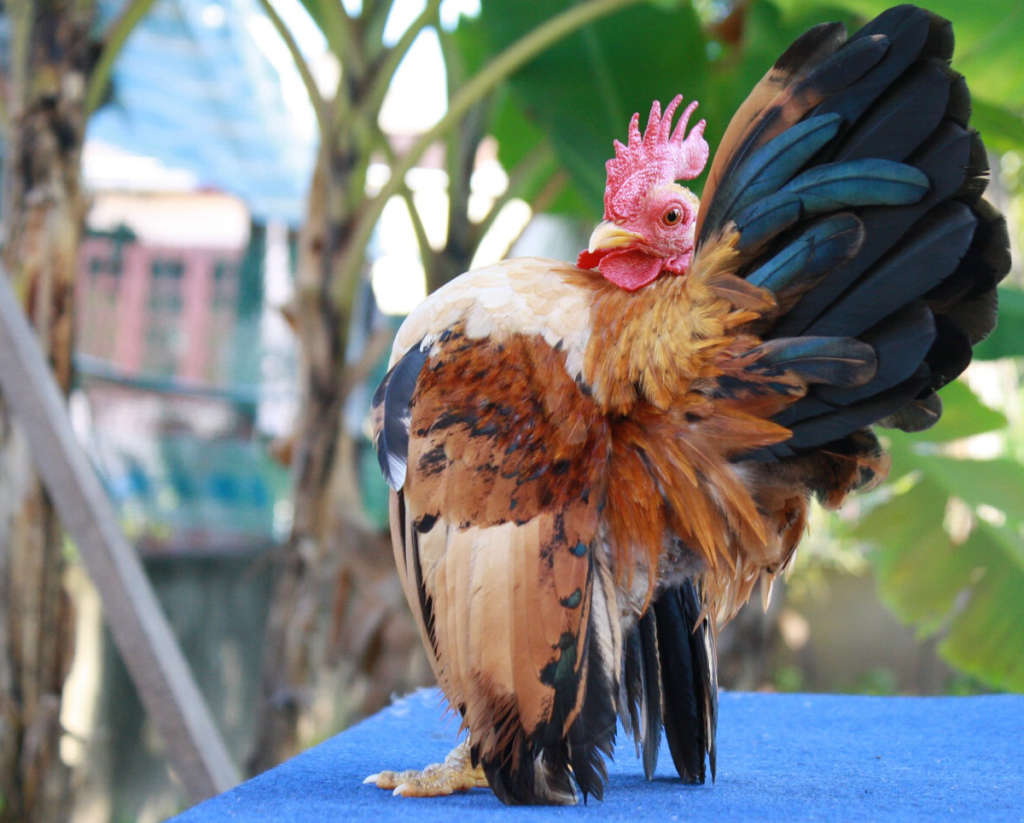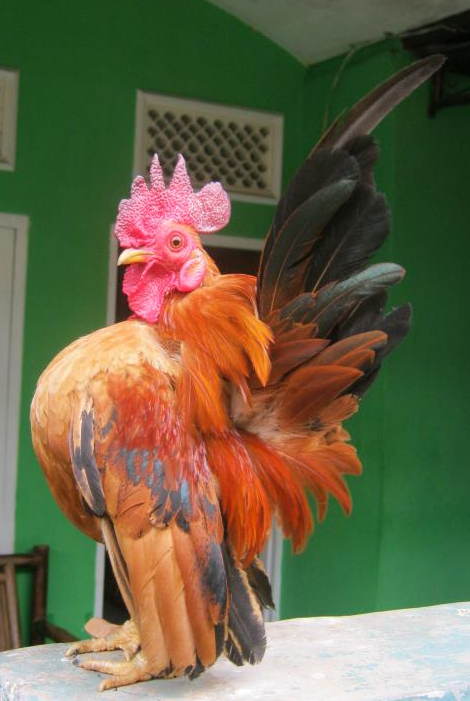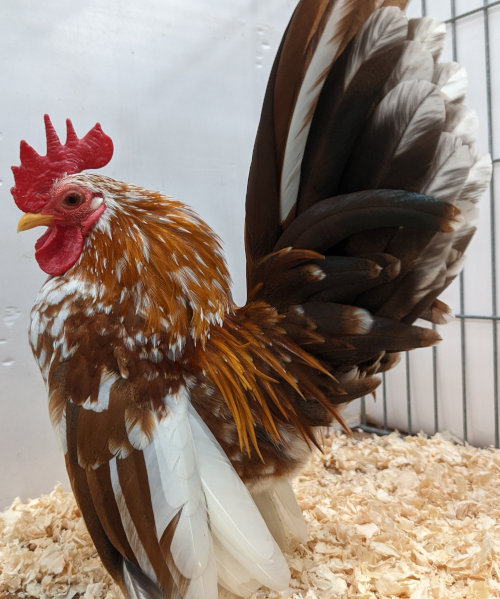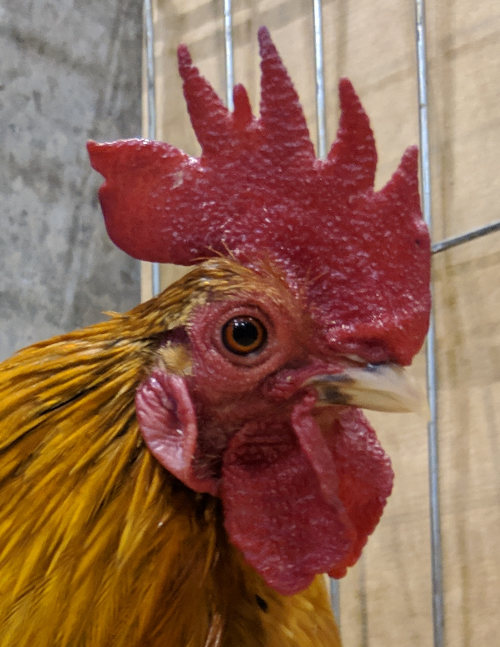Serama bantam breed standards.

Serama breed standards?
The outline of the bird or "silhouette" distinguishes the Serama at a glance with it's upright tail, high prominent breast, low wing and head held far back nearly against the tail. The overall effect of tail , neck and head is a V shape. The back should be very short and nearly completely covered by the hackle and saddles so as to appear nearly nonexistent.
Below: A fine example of a Serama Bantam:

Mature cockerels:
Class A - up to 350 grams (12.35 oz.)
Class B - up to 500 grams (17.64 oz.)
Class C - up to 600 grams (21.16 oz.)
Mature hens:
Class A - up to 325 grams (11.46 oz.)
Class B - up to 425 grams (14.99 oz.)
Class C - up to 500 grams (17.64 oz.)
Cockerels - one class only:
150 to 350 grams (5.29 to 12.35 oz.)
Pullets - one class only:
150 to 325 grams (5.29 to 11.46 oz.)
Chick category:
Regardless of sex - up to 150 grams (5.29 oz.)
Points:
Type - 25 points
Temperament - 20 points
Tail Carriage - 20 points
Wings - 10 points
Body - 5 points
Legs - 5 points
Feather Structure - 5 points
Comb/Wattles - 5 points
Appearance - 5 points
Total possible points - 100
Type:
Type is the overall outline and shape of the Serama, including the way the bird carries itself. Even as a shadow on a wall, you should be able to readily identify it.
The main features of the Serama are the head held far back on the body, the full breast, the short back, the nearly vertical wing carriage and the long, full, spread tail that either touches the back of the comb during pose or comes close to doing so.
The centre of the eye should be in line with the centre of the legs when your Serama is standing posed.The birds best in type should have a combination of all traits mentioned in the standard that makes the Serama distinct. Excellent type should be the most important characteristic found in this breed. Without type, you do not have a true Serama.
Temperament:
The Serama's personality should be bold , fearless, and assertive. The best bird will be a real "show off" having an obvious desire to strut, pose and verbalise. However, overly aggressive birds, as well as shy, listless or cowardly birds, should not be used as breeders.
Below: A Serama proudly strutting around.
The personality of the Serama is another trait that should receive special attention when breeding. The Serama should be calm, manageable and easily handled. Showing no aggressiveness, but still possessing an assertive personality. The bird should pose easily and readily. Frightened or shy birds are as unsuitable as are aggressive and mean birds.
Tail:
Relatively large in size, carried very high, perpendicular to the ground. Should have a full spread front to back with no gaps in the feathers. There should be no space between the tail and the back. When the bird is posed, the tail should touch the back of the comb or very nearly do so with the gap being 5 cm or less.
Very high and upright, at a 90 degree angle from the ground. The tail is carried parallel to the neck and should be relatively large and wide with full feathering. Further, the tail must have no falling to one side or the other (wry tail).
True Main Tail - These feathers are to be long and wide. They should overlap to some extent, the overall effect is as a set of steps, as the feathers go from the tallest front feathers to the shortest ones in back. When viewed from behind, the main tail is open at an angle of 45 degrees, creating an open V shape from behind.
Below: The Tail is impressive on Serama bantams.

Tail feathers should be profuse, as many as possible. These feathers should well fill in the base of the tail giving a full and profuse look to the tail base. .
Main Tail Feathers - Long, broad, rigid and rounded at the end, each of these feathers should overlap the one below it on the outside. Looking from the rear, the main tail should spread open and resemble an inverted V with a 45 degree angle.
Sickles - These two feathers should be long, broad and of equal length. Should curve only very slightly toward the rear of the bird and come to a point. The sickles should protrude a good distance out from the main tail feathers and be at a 90 degree angle from the ground.
Profuse, wide and medium in length. These feathers are to be somewhat curved as is general in all rooster feathered breeds. These may protrude slightly beyond the main tail feathers and there should be as many of them as possible.
Lesser or Secondary sickle feathers - Of medium length and slightly curving to a point, these feathers should make up the flow of and fill in the tail without protruding past the main tail feathers. They should be abundant.
Tail Coverts - There should be an abundance of these small feathers covering the base of the tail.
Wings:
Should be fairly large in proportion to the body. In stance, the wings should approach a vertical position but still have a slight angle toward the rear such that the centre of the wing tip falls just behind the leg in alignment while the centre at the top (shoulder) aligns with the eye. The wings should lightly touch the ground but not drag excessively. They should be held tightly folded when the bird is not posing.
The wings are to be large, but not so large as to drag the ground or to be longer than the foot. The wing must clear the ground and is to be well folded and should be completely vertical, straight up and down.
Shoulders and fronts - Set high and the bird, the hackles should flow over and conceal the tops.
Bows - Smooth and round
Covert feathers - broad, prominent and forming a visible bar across the wing between the shoulders and primaries.
Primaries - Long in length and of medium width, the primaries should be strong with the secondaries partially overlapping them at the top.
Secondaries - Moderately long and broad
Body:
The body should be muscular and well rounded. Viewed from a top angle, it should be wider in the front chest area than the rear, forming a teardrop or heart shape. From the side, it should show the distinct narrow V-shape this breed is known for.
Body is to be full and well muscled. From a top view the body shape is somewhat elliptical, with more prominence and width in the area of the breast. When viewed from a standing side angle, the body shape is somewhat vase like, creating a wide V shape with the head held well back and the back of the comb touching or nearly touching the tail.
Saddle:
Profuse and in abundance, of medium length, flowing onto the secondaries and onto the back edge of the wing. The saddles should fill in the area between the wing and the tail.
Back - Should be very short and wide at the shoulders. Completely covered by the hackle feathers which should meet an abundance of saddle feathers that start at the wing. This makes the back nearly invisible.
Chest - Should be carried very high in a proud stance, held upright higher than the hips, just slightly above the tail bed. It should be very full in both depth and width, very well rounded and protruding forward. Almost appears double-breasted.
Shoulders should be covered at the top by the hackles and should be strong and well rounded, set high.
Legs:
The legs are to be of medium length and are to be set wide, allowing for a full and muscular undercarriage of the body. There should be no narrowness or knock knees, the overall effect being of well set, very stable legs that are a strong support to the bird. Should be in proportion to the wing length to allow them to be lightly touching the ground without dragging during pose.
The legs must be long enough to allow the ends of the wings to be above the ground.
Upper Leg - Medium in length and well muscled
Thigh - Muscular at the top, tapering downward and of medium length.
Shank - Of moderate length and thickness with tightly overlapping, prominent scales that are not loose or scaly looking. Medium in length of good thickness not to look too delicate. The shank must not be short or absent. The scales should be prominent and in good condition.
Spur - Set slightly below centre of the shank, it should be hard and small in size. Should be set straight back as not to interfere with walking or wing carriage.
Toes - Three forward facing toes, of shorter length and well spaced. One rearward facing toe. There must be four toes which should be well placed, solid and strong.
Feathers:
Body feathering should be of medium density, clean, well groomed and shiny. All feathers should be neat and show good structure with broad, solid webbing. Feathers should show no fraying.
All feathers must be well structured and of fine form in clean condition and showing a glossy shine. The body feathers are to be full, profuse, not fluffy, but not tightly feathered either. A medium feather structure is preferred.
Covert feathers should form a distinct bar below the shoulder and above the main wing feathers (primaries).
Primaries and secondaries. Broad with the overall effect of the wing being one of great strength and fullness. The secondaries fall over the upper part of the primaries, partially covering them.
Comb and wattle:
The comb is to be of small to medium size and is of the single form, with five points preferred, but more points are allowed. Should be straight and stand upright without any part laying over.
Below: The comb and wattles of the Serama bantam.

The comb and wattles should be almost smooth except for a fine texture and have no wrinkles or other abnormalities. Wattles should be of medium size to compliment the comb, slightly elongated and rounded at the bottom. They, too, should be free of folds or wrinkles.
The comb is to be of smooth structure without folds or any deformities.
Appearance:
Vigorous, healthy and strong. Bird should look clean and well cared for. Bold and alert, overall "feel" of well-being.
The overall appearance of the bird is to be one of health and vitality. The bird must show good temperament and be amicable to handling. The bird is to be clean, and showing proper show grooming, with all feathers intact.
